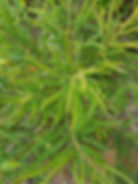Sweetfern is not a fern at all, but a deciduous, low-growing, shrubby member of the bayberry family. As its common name suggests, the twigs and fern-like leaves have a pleasant aroma when crushed. Sweetfern is the only living species in its genus (Comptonia honors Rev. Henry Compton, a patron of botany), and it’s often found on dry, sandy, or gravelly sites in the eastern United States and Canada and as far west as Minnesota. The shrub has a lush, exotic appearance with masses of narrow, dark green leaves that are deeply lobed and up to 6” long. Small, yellowish-green flowers and brown catkins bloom in early summer before the leaves unfurl, followed by small, burr-like nutlets in June and July. The plant typically grows about 3’ tall and 5’ wide with loose, spreading branches and an erect, rounded form. It thrives in sandy, well-drained soils and full or part sun, but it adapts to average or wet conditions as long as it’s not sited in heavy clay or shade. Sweetfern tolerates wind, drought (once established), and salt and has no significant pest or disease issues. Some resources comment that it doesn’t transplant well, but at least one source notes that transplants may survive if they are not relocated in rich, fertilized soils.
Despite sweetfern’s delicate common name and appearance, it’s a useful and hard-working plant. Nitrogen-fixing bacteria in the root nodules convert atmospheric nitrogen into a form that’s usable by plants, and this ability to improve poor soils makes it a popular choice for highway plantings, waste areas, and other demanding sites. Comptonia, which means “one that travels,” likely refers to the plant’s habit of reproducing almost solely by rhizomes to form colonies. It’s often used for erosion control on slopes or for massing along the foundation of a building. The seeds rarely germinate in the wild because they contain a germination inhibitor and usually remain dormant in the soil for up to 70 years. Sweetfern is endangered in Ohio due to roadside mowing, clearing of fencerow thickets, insect predators, and overshading by woody species, according to the Ohio Department of Natural Resources. It has been found in open oak forests, pastures, and roadsides in only a few counties in Ohio.
Native habitats include dry, open woodlands; roadsides; and dry, sterile, sandy fields in full sun. Use in naturalized areas, under evergreens, in rain and butterfly gardens, as a groundcover, or to stabilize slopes.
Plant Characteristics:
Grows 2-5’ tall and 4-8’ wide.
Prefers full or part sun.
Best sited in average to dry moisture and acidic loamy or sandy soils, but adapts readily to other well-drained soils. Tolerates wet sites and drought.
Blooms April-May with ¾-1 ½”, brown male catkins clustered at the ends of branches and ½”, yellowish-green female flowers that give way to bristly, ¾” fruits containing clusters of nutlets from June-July.
Leaves are typically green, deeply notched, 2-6” long and about 1” wide. Upper surface is medium green and underside is light green. Immature leaves are yellowish green with silky hairs. The color is sometimes a mixture of red, orange, or yellow.
Bark is gray or reddish brown, mostly smooth, and scattered with white lenticels.
Wildlife Value:
Sweetfern is a larval host plant for 49 species of Lepidoptera, including the sweetfern underwing moth and the gray hairstreak butterfly. Sweetfern is sometimes browsed by deer during winter.
Medicinal, Edible, and Other Uses:
A tea made from the leaves is used to treat the symptoms of dysentery and counteract the effects of poison ivy.
Steep the fresh leaves to make a mild, earthy tea. The leaves may also be used as a meat or fish rub or infused in soups to provide flavor and aroma. Similar to bay leaves, remove the rough-textured leaves before serving the soup. Dried seeds can be ground and used as a spice to flavor soups, beans, desserts, and alcohol. Foragerchef.com has a handful of sweetfern recipes, including sweetfern cookies and blueberry-sweetfern sauce.
Sweetfern, Comptonia peregrina
We will receive our bare root order from a partner nursery in Michigan in late March. Orders placed now will be reserved for pickup starting when we open April 3.

